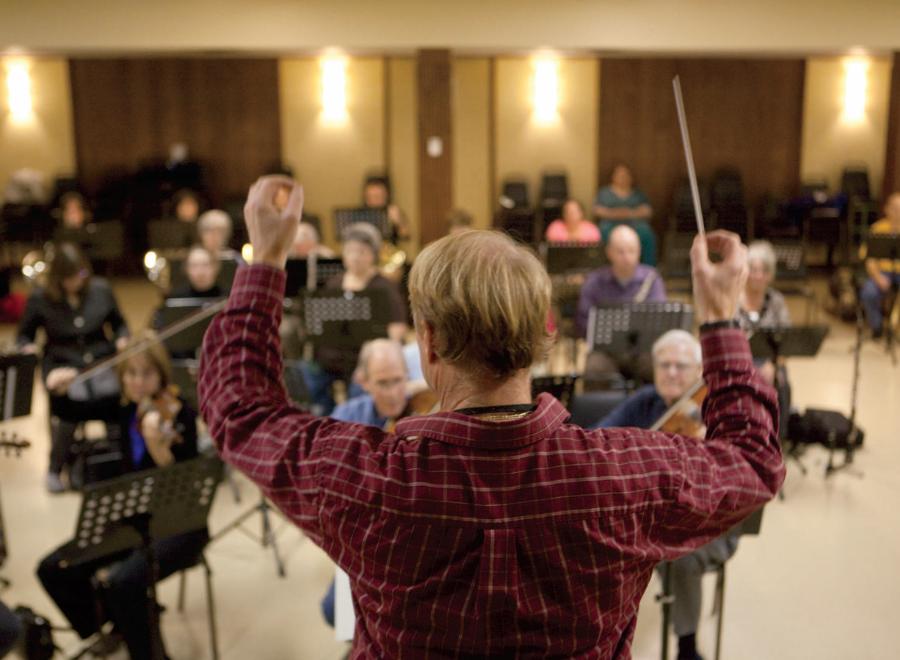When Paul Caron retired a few years ago, he decided to rekindle a long-lost love. He had studied music as a teenager, but teaching French in Ontario’s public school system had kept him busily distracted from it for years. At age 55, Caron signed up for clarinet lessons. Eventually, he found himself playing in seven different musical groups. “I’m practically a full-time musician,” he says. “It would be a second career if it weren’t for the fact that I don’t get paid.”
Among Caron’s musical commitments is the Parkdale United Church Orchestra in Ottawa. He feels fortunate to have snatched one of its two seats for clarinets. “You can get together with a group of friends and play chamber music, but there aren’t many opportunities to play with a full-sized orchestra,” he says.
Nor are there many opportunities to hear symphonic music in church. Parkdale is the only congregation in The United Church of Canada to be formally affiliated with an orchestra. The enthusiasm of players like Caron makes the group an amateur orchestra in the original sense of the word: amator is Latin for “lover,” and the love of music has been the group’s lifeblood over the years.
The orchestra began almost by accident in 1945, when former Parkdale United organist Cliff Templer assembled three violinists and a pianist to play at church services once a month. Some months later, he recruited a clarinetist, oboist, cellist and bassist for a concert. From there, the group grew to include the 55 to 60 musicians that play in it today.
The largest symphonic orchestras have over 100 players, but that would be too many to fit in the front of a church sanctuary. “Besides,” says flautist and long-time Parkdale Orchestra member Vic Norian, “a lot of classical pieces were originally written for groups of our size.”
Although most of the musicians are not members of Parkdale United, the orchestra maintains its ties to the church by renting a rehearsal space there and by playing hymns, preludes and postludes for Sunday services twice a year. On those occasions, the choir swells with extra singers to match the orchestra’s broad sound, and the pews fill with appreciative listeners. “Last time, I had people come up to me afterwards and say they felt like they had been at the National Arts Centre,” says the church’s music director, Troy Cross.
“People are used to going to church and hearing a choir and an organ,” adds Norian. “So when you come in and hear 60 extra musicians, it’s such a spectacle.”
Church orchestras weren’t always as remarkable as they seem today. In the 18th century, it was common all over Europe to hear a symphony or a violin concerto played during a church service. Pope Benedict XIV finally acknowledged church orchestral music in a 1749 decree. “Where it has been introduced, it may be tolerated,” he wrote dryly, “so long as it is serious and does not — because of its length — cause boredom or serious inconvenience to those in the choir or the celebrants at the altar.”
According to the music historian John Spitzer, church orchestras helped to nourish orchestral music in general by providing a regular source of income for musicians and composers. For instance, archival records show that St. Mark’s Basilica in Venice once had 48 orchestra members on its regular payroll.
A contemporary church treasurer would shake her head in wonder at the idea of including such a luxurious expense in the budget, so needless to say, it’s enjoyment rather than a paycheque that brings the Parkdale United Church Orchestra out to practices each week.
On a Tuesday rehearsal night, a hodgepodge of sounds floats down the hall from the sanctuary. Clarinetists break in their squeaky reeds, trombonists grease their slides and violinists run up and down the scale to warm up.
A quick glance around the room shows that the orchestra has enticed people of all ages and cultural backgrounds.
Their professions range from retirees to students, from doctors and engineers to stay-at-home parents. Slowly and with a lot of chattering, the musicians arrange themselves into a familiar semi-circular shape. Conductor Angus Armstrong brings order to the room by tapping his baton. “The first piece tonight is really kind of tricky,” he says playfully.
Armstrong seems to enjoy pushing his players to their technical limits, although he makes concessions for their level of ability. He adapts the occasional score and allows violinists to play every other note during quick passages that would otherwise be out of their reach. “Most of them have day jobs, so I can’t ask them to practise four hours a day,” he says.
Nevertheless, this season’s repertoire includes serious and demanding pieces. In January, the Parkdale Orchestra will perform a pair of string concertos by the Romantic composers Tchaikovsky and Bottesini. And in May, it will put on a concert with a Viennese theme, featuring a Schubert overture and Beethoven’s sixth symphony.
In the front row, leading the violins through those wrist-contorting tricky passages, sits Tim Yaychuk, the orchestra’s only professional player. As the concertmaster, he has the duty of tuning the orchestra. He must also learn the music quickly so that the rest of the players have someone to imitate.
Under his dark beard, Yaychuk’s face is relaxed and smiling. Playing in an orchestra hasn’t always pleased him this way. “In a professional group, the job satisfaction rate is abysmal — on the same order as prison guards,” he says. “And there are petty politics. Sometimes people seem no better than kindergarten students.”
Yaychuk blames the dispiritedness of professional orchestras on low funding, pay cuts and an overly competitive atmosphere. Parkdale United Church Orchestra, on the other hand, is fun. It’s even maybe a bit too much fun at times. “When I first arrived seven or eight years ago, the group was very healthy socially but not so healthy musically,” he says. “Everyone liked to talk together and brag about how little they’d practised that week.”
Since Armstrong took over the baton, the orchestra has been taking its music more seriously, says Yaychuk. “Every concert is more musical than the previous one, and that’s exciting,” he says. “We tend to put on a pretty good show these days.”
On concert nights, the orchestra dresses smartly, with the women in elegant black tops and the men in dark suits with black bow ties. For Norian, the concerts are terrifying but delightful. Like many musicians, he gets nervous before performing but feels a high while he is on the stage. “A friend recently asked me to go rock climbing with him, but I told him I already get a similar thrill from performing,” he says. “And there’s less chance of breaking a bone.”
Before the show starts, when the oboe sounds its A and the rest of the instruments tune to it, centuries of tradition seem to reverberate through Parkdale United’s tall building. “You’re actually playing some of the world’s greatest music, written by some of history’s greatest minds, in the biggest kind of instrumental ensemble there is,” says Norian. “It’s an opportunity that money can’t buy.”
***
This story first appeared in The United Church Observer’s December 2010 issue with the title “Symphony in the sanctuary.”


Comments